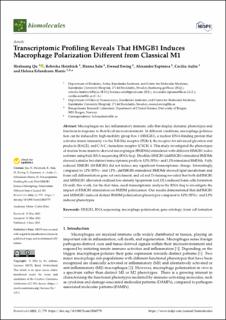| dc.contributor.author | Qu, Heshuang | |
| dc.contributor.author | Heinbäck, Rebecka | |
| dc.contributor.author | Salo, Henna | |
| dc.contributor.author | Ewing, Ewoud | |
| dc.contributor.author | Espinosa, Alexander | |
| dc.contributor.author | Aulin, Cecilia | |
| dc.contributor.author | Harris, Anna Helena Erlandsson | |
| dc.date.accessioned | 2022-12-02T14:26:45Z | |
| dc.date.available | 2022-12-02T14:26:45Z | |
| dc.date.created | 2022-09-07T13:52:57Z | |
| dc.date.issued | 2022-06-02 | |
| dc.identifier.issn | 2218-273X | |
| dc.identifier.uri | https://hdl.handle.net/11250/3035696 | |
| dc.description.abstract | Macrophages are key inflammatory immune cells that display dynamic phenotypes and functions in response to their local microenvironment. In different conditions, macrophage polarization can be induced by high-mobility group box 1 (HMGB1), a nuclear DNA-binding protein that activates innate immunity via the Toll-like receptor (TLR) 4, the receptor for advanced glycation end products (RAGE), and C-X-C chemokine receptor (CXCR) 4. This study investigated the phenotypes of murine bone-marrow-derived macrophages (BMDMs) stimulated with different HMGB1 redox isoforms using bulk RNA sequencing (RNA-Seq). Disulfide HMGB1 (dsHMGB1)-stimulated BMDMs showed a similar but distinct transcriptomic profile to LPS/IFNγ- and LPS-stimulated BMDMs. Fully reduced HMGB1 (frHMGB1) did not induce any significant transcriptomic change. Interestingly, compared to LPS/IFNγ- and LPS-, dsHMGB1-stimulated BMDMs showed lipid metabolism and foam cell differentiation gene set enrichment, and oil red O staining revealed that both dsHMGB1 and frHMGB1 alleviated oxidized low-density lipoprotein (oxLDL)-induced foam cells formation. Overall, this work, for the first time, used transcriptomic analysis by RNA-Seq to investigate the impact of HMGB1 stimulation on BMDM polarization. Our results demonstrated that dsHMGB1 and frHMGB1 induced distinct BMDM polarization phenotypes compared to LPS/IFNγ- and LPS- induced phenotypes. | en_US |
| dc.language.iso | eng | en_US |
| dc.publisher | MDPI | en_US |
| dc.rights | Navngivelse 4.0 Internasjonal | * |
| dc.rights.uri | http://creativecommons.org/licenses/by/4.0/deed.no | * |
| dc.title | Transcriptomic Profiling Reveals That HMGB1 Induces Macrophage Polarization Different from Classical M1 | en_US |
| dc.type | Journal article | en_US |
| dc.type | Peer reviewed | en_US |
| dc.description.version | publishedVersion | en_US |
| dc.rights.holder | Copyright 2022 the authors | en_US |
| dc.source.articlenumber | 779 | en_US |
| cristin.ispublished | true | |
| cristin.fulltext | original | |
| cristin.qualitycode | 1 | |
| dc.identifier.doi | 10.3390/biom12060779 | |
| dc.identifier.cristin | 2049522 | |
| dc.source.journal | Biomolecules | en_US |
| dc.identifier.citation | Biomolecules. 2022, 12 (6), 779. | en_US |
| dc.source.volume | 12 | en_US |
| dc.source.issue | 6 | en_US |

